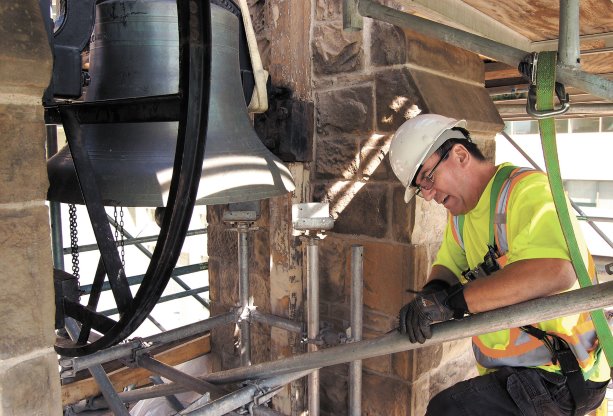Elevating a two-ton swinging bell out of its bushings was one of campanologist John Scott’s most challenging projects.
"But they’re all challenging," says Scott, who practices one of the most unique tradesperson/service technician/consultants careers in the construction business.
Owner and sole-operator of Waterdown, Ont.-based Scotiabell, Scott services, repairs, and updates the technology on bells and clocks on existing buildings such churches and Toronto’s Old City Hall, as well as installing them on new office towers and other buildings.
A major component of the business is providing a range of feasible installation options to owners, architects and contractors. It’s a profession that requires him to don a helmet and safety equipment one day, but then attend a development planning meeting another day.
During those meetings he will recommend the best approach to servicing an existing bell or clock or installing a new one, but the final decision is made by the client.
"Each bell and clock is different," says Scott, explaining that by participating in the development meetings he can recommend the best product. Although the timing of the servicing or installation varies, it often occurs near the end of the construction project.
On most assignments Scott does all of the work using a range of equipment from hand tools to chain falls to heavy cranes. When necessary, he can call on a select team of tradespeople including an electrician and an engineer to assist on projects. Because he "can’t be in the office all day looking at the computer," he also employs a full-time office administrator.
"I never stop learning," says Scott, 58, who has been working in the trade for 33 years. He began as apprentice to his uncle, C. Arthur Scott, who started the family business in 1922. C. Arthur had a number of ventures, but branched into repairing church bells in the 1950s and was one of only a handful of Canadians to be recognized as a Tintinnabulator.
"I like to tinker and it was suggested I apprentice with uncle Art. It (the apprenticeship) was fairly intense."
His uncle’s philosophy about servicing bells was that it was, "one third music, one third mechanics and one third electronics. I had the mechanical and musical ability and took courses to increase my knowledge of electronics."
The uncle/nephew team travelled all over Ontario in an RV camper to various sites. Their first project, and still only one, outside of Canada was a church in New York State. Four jacks were required to lift the two ton bell out of its bushings in order to refurbish the bearings, while the two men stood in the bell chamber some eight storeys above ground level.
"If one of the jacks had failed, the bell would have fallen to the ground."
After his uncle died in 2004, Scott took over the business and gave it a new name — Scotiabell which is play on his name and the nature of his business.
At one time, approximately 90 per cent of the business volume was servicing and installing church bells.
"But the pendulum has swung and it’s now more focused on clocks."
That’s not to say church bell work has dried up. As part of a much larger exterior masonry restoration, Scott recently repaired the bell of the Church of the Redeemer in Toronto. It hadn’t been rung for 15 years for fear the vibrations would further jeopardize the fragile bell tower which has now been rebuilt.
As part of his consultation on that job, he presented three options for ringing the bell. They included an updated rope pull, an electronic peal motor, or an electro-magnetic hammer, a system in which the ringing is created by the hammer hitting a stationary bell. The church opted for the more traditional rope pull.
When asked if his profession is growing or dying, Scott says it not growing enough to sustain a flood of trainees. But, at the same time, it’s not a dying art because his firm is very healthy with consultations, appraisals, sales, services, and installations.











Recent Comments
comments for this post are closed